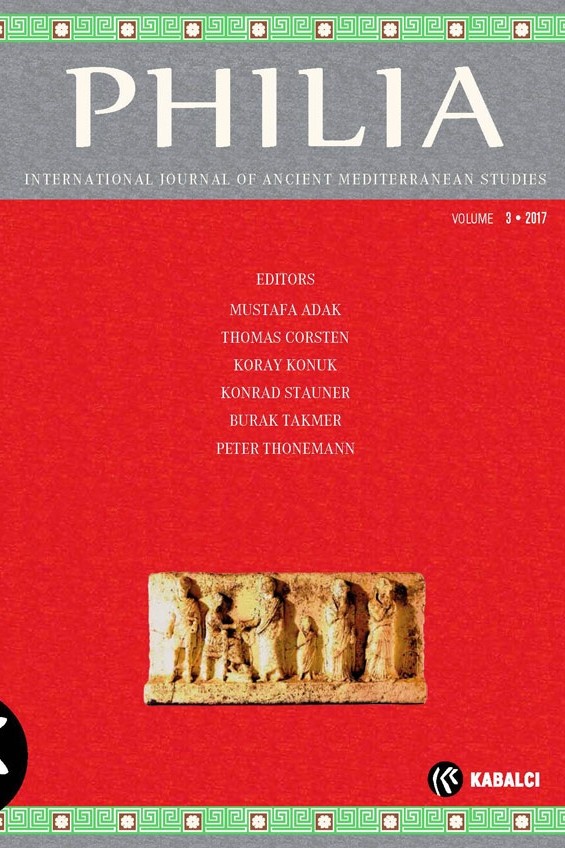Eski Yunan Atletizminde Seyirci-Atlet Etkileşimi
Yazar makalesinde Phaselis’ten İ.S. 3. Yüzyıla
tarihlenen agonistik bir yazıtttan (SEG 55, 1473) yola çıkarak, festivallerde
seyircilerin tutum ve davranışlarını incelemektedir. Sporcu müsabakalarını
izleyen seyircilere yönelik yazıtların oldukça az olması, edebi kaynakların
daha ziyade sporculara, yarışmalara değinmeleri nedeniyle Antik Dönem’de
sporseverlerin düşünce yapılarını ve davranışlarını anlamak güç olduğu için Phaselis
yazıtı gibi kısıtlı sayıda yazıt bu nedenle önem arz etmektedir. Yazar, bu
yazıt üzerinden berabere sonuçlanan müsabakalarda seyircilerin bu karar
karşısında tutumunun nasıl olduğunu ve Antik Dönem atletizminde spor seyirciliğinde
yansımaları tartışmaya sunmaktadır. Seyircilerin kendi kendilerine yarışmada
alınan sonuçlara hüküm veremedikleri ama çoğunlukla da yarışmada görev alan memurların
kararını etkilemeye, akıllarını çelmeye çalıştıkları bilinmektedir. Phaselis
yazıtında da benzer durumlar çok büyük bir olasılıkla yer almaktaydı.
Anahtar Kelimeler:
Yunan atletizmi, seyirci davranışı, atletler, memurlar, bayram, agonistik yazıtlar
Spectator-Athlete Interaction in Ancient Greek Athletics
Taking SEG 55, 1473 as a starting point, this
paper examines the evidence for draws and spectator behavior in Greek
athletics. Even though spectators were usually demonstrative and at times even
interacted with athletes, it was always at the discretion of the officials of a
festival to award a joint victory. Spectator approbation was highlighted in agonistic
inscriptions as a token of distinction for late antique victors.
Keywords:
Greek athletics, spectator behavior, athletes, officials, festival, agonistic inscriptions,
___
- Adak et al. 2005 M. Adak – N. Tüner Önen – S. Şahin, Neue lnschriften aus Phaselis I, Gephyra 2, 2005, 1–20.
- Barry 1993 W. D. Barry, Aristocrats, Orators, and the “Mob”: Dio Chrysostom and the World of the Alexandrians, Historia 42, 1993, 82–103.
- Bérard 1892 V. Bérard, Inscriptions d’Asie Mineure, BCH 16, 1892, 417–446.
- Brunet 2011 S. Brunet, Living in the Shadow of the Past: Greek Athletes During the Roman Empire, in: Barbara Goff – Michael Simpson (eds.), Thinking the Olympics: The Classical Tradition and the Modern Games, London 2011, 90–108.
- Crowther 2000 N. B. Crowther, Resolving an Impasse: Draws, Dead Heats and Similar Decisions in Greek Athletics, Nikephoros 13, 2000, 125–140.
- Earnheardt – Haridakis 2009 A. C. Earnheardt – P. M. Haridakis, An Examination of Fan-Athlete Interaction: Fandom, Parasocial Interaction, and Identification, Ohio Communication Journal 47, 2009, 27–53.
- Ebert 1997 J. Ebert, Zur neuen Bronzeplatte mit Siegerinschriften aus Olympia (Inv. 1148), Nikephoros 10, 1997, 217–233.
- Ebert – Siewert 1999 J. Ebert – P. Siewert, Eine archaische Bronzeurkunde aus Olympia mit Vorschriften für Ringkämpfer und Kampfrichter, in: A. Mallwitz (ed.), Bericht über die Ausgrabungen in Olympia XI, Berlin 1999, 391–412.
- Frederick et al. 2012 Evan L. Frederick – C. H. Lim – G. Clavio – P. Walsh, Why We Follow: An Examination of Parasocial Interaction and Fan Motivations for Following Athlete Archetypes on Twitter, International Journal of Sport Communication 5, 2012, 481–502.
- Gardiner 1929 E. N. Gardiner, Regulations for a Local Sports Meeting, CR 43, 1929, 210–212.
- Golden 2004 M. Golden, Sport in the Ancient World from A to Z, London – New York 2004.
- Gounaropoulou – Hatzopoulos 1998 L. Gounaropoulou – M. Hatzopoulos, Επιγραφές κάτω Μακεδονίας (Μεταξύ του Βερμίου όρους και του Αξιού ποταμού). Τεύχος Α´. Eπιγραφές Βεροίας. Athens 1998.
- Horton – Wohl 1956 D. Horton – R. R. Wohl, Mass Communication and Para-social Interaction: Observations on Intimacy at a Distance, Psychiatry 19.3, 1956, 215–229.
- Hunink 2011 V. Hunink, Glücklich ist dieser Ort! 1000 Graffiti aus Pompeji, Stuttgart 2011.
- Lee 2001 H. M. Lee, The Program and Schedule of the Ancient Olympic Games, Hildesheim 2001.
- Merkelbach 1974 R. Merkelbach, Der unentschiedene Kampf des Pankratiasten Ti. Claudius Rufus in Olympia, ZPE 15, 1974, 99–104.
- Moretti 1953 Luigi Moretti, Iscrizioni agonistiche greche. Rome 1953.
- Papakonstantinou 2014 Z. Papakonstantinou, Ancient Critics of Greek Sport, in: P. Christesen – D. Kyle (eds.), A Companion to Sport and Spectacle in Greek and Roman Antiquity, Chichester and Malden 2014, 320–331.
- Papakonstantinou, forthcoming Z. Papakonstantinou, Law, Litigation and Sport in Ancient Greece, forthcoming in: T. Scanlon – A. Futrell (eds.), Oxford Handbook of Sport and Spectacle in the Ancient World, Oxford – New York.
- Poliakoff 1987 M. B. Poliakoff, Combat Sports in the Ancient world: Competition, Violence and Culture, New Haven 1987.
- Pritchard 2013 D. M. Pritchard, Sport, Democracy and War in Classical Athens, Cambridge 2013.
- Ramsay 1888 W. M. Ramsay, Antiquities of Southern Phrygia and the Border Lands (II), AJA 4, 1888, 6–21.
- Tanrıver 2009 C. Tanrıver, Three New Inscriptions from Tripolis, EA 42, 2009, 81–86.
- van Nijf 1999 O. van Nijf, Athletics, Festivals and Greek Identity in the Roman East, Proceedings of the Cambridge Philological Society 45, 1999, 176–200.
- van Nijf 2001 O. van Nijf, Local Heroes: Athletics, Festivals and Elite Self-fashioning in the Roman East, in: S. Goldhill (ed.), Being Greek under Rome: Cultural Identity, the Second Sophistic and the Development of Empire, Cambridge – New York 2001, 306–334.
- van Nijf 2003 O. van Nijf, Athletics, andreia and the askêsis-culture in the Roman East, in: R. M. Rosen – I. Sluiter (eds.), Andreia: Studies in Manliness and Courage in Classical Antiquity, Leiden 2003, 263–286.
- Woodward – Ormerod 1909/1910 A. M. Woodward – H. A. Ormerod, A Journey in South-Western Asia Minor, ABSA 16, 1909/1910, 76–136.
- Wörrle 1988 M. Wörrle, Stadt und Fest im kaiserzeitlichen Kleinasien. Studien zu einer agonistischen Stiftung aus Oinoanda, Munich 1988.
- ISSN: 2149-505X
- Başlangıç: 2015
- Yayıncı: Kabalcı Yayıncılık
Sayıdaki Diğer Makaleler
Karia’da Yunanca Epigramlar – Yerli Nüfusun Helenleşmesine dair Veriler
İmparatorluk Dönemi’nde Perge Akropolis’i ve Kent için Önemi
Septimius Severus, Iulia Domna ve Perinthos
Zotion Adı ve Ignatius’un Mektubunun Güvenilirliği
İmparator Hadrianus’un Mysia ve Bithynia’da İmar Projeleri
Mısır’ın Doğu Çölünden Roma Ordu İdaresi hakkında yeni Belgeler: Didymoi Karakolu’ndan Ostrakonlar
Eski Yunan Atletizminde Seyirci-Atlet Etkileşimi
Bithynia Metropolü Nikaia’da Nemesis ve bir Asia Eyaleti Prokonsülü
